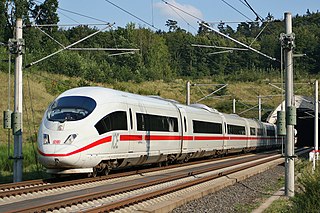
A multiple-unit train is a self-propelled train composed of one or more carriages joined, and where one or more of the carriages have the means of propulsion built in. By contrast, a locomotive-hauled train has all of the carriages unpowered.
The London, Midland and Scottish Railway (LMS) introduced a number of railcars to service between 1933 and 1939. Most were single units but one was a three-car articulated set.

Enterprise is the cross-border inter-city train service between Dublin Connolly in the Republic of Ireland and Belfast Grand Central in Northern Ireland, jointly operated by Iarnród Éireann (IÉ) and NI Railways (NIR). It operates on the Belfast–Dublin railway line.

The British Rail Class 432 (4-REP) electric multiple unit passenger trains were built by BR at York Works from 1966 to 1967 and in 1974. The units were built to power the TC trailer units on services on the South West Main Line. Fifteen four-car units were eventually built. The motor coaches were new build, but the trailers were converted from Mk1 hauled stock. They were initially classified as Class 441 and numbered 3001–3015. This was later changed to Class 430, under which they spent the majority of their working lives. Shortly before withdrawal they were reclassified Class 432 and the units were renumbered as 2001–2015. The fleet had a lifespan of 26 years.
Push–pull is a configuration for locomotive-hauled trains, allowing them to be driven from either end of the train, whether having a locomotive at each end or not.

The British Rail Class 126 diesel multiple unit was built by BR Swindon Works in 1959/60 to work services from Glasgow to Ayrshire and comprised 22 3-car sets and were a development of the earlier Swindon-built trainsets that had been introduced in 1955 to work the Edinburgh Waverley - Glasgow Queen St services. These vehicles formed the first Inter City service to be operated by diesel units in Great Britain.

The Ulster Transport Authority Multi-Engined Diesel was an early diesel powered railcar, used in Northern Ireland. The 12-mile Belfast-Bangor railway line had a well used passenger service and, being devoid of goods traffic, was chosen as the testing ground for the diesel railcar era. Before deciding to build its own railcars the UTA conducted an experiment by borrowing from the GNR(I). This was considered such a success that the UTA constructed its own experimental three-coach diesel railcar set at its Duncrue Street works, this being outshopped in late Spring 1951, ready for testing and driver training.
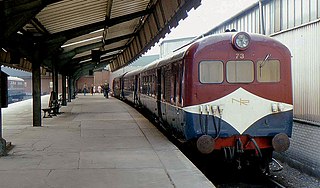
UTA 70 class was a diesel multiple unit train built for service on the Ulster Transport Authority's railway network. The MED’s and MPD’s, which made use of readily available power and transmission units, were cheap to operate but noisier and not as comfortable as locomotive-hauled rolling stock, a fact which made them unsuitable for Inter-City journeys. The decision was made to develop a new generation of multiple unit and in July 1966 the first of the new DEMU sets entered service.

The 80 Class is a type of diesel electric multiple unit formerly used by Northern Ireland Railways. They were affectionately nicknamed 'Thumpers' by rail enthusiasts due to the thumping noise their engines produced.

Following the end of World War II, most railways throughout the world were looking to either update their fleet of steam locomotives with new and more economical designs or look towards alternatives, which for many meant a programme of dieselisation. The main considerations were the rising cost of coal against diesel oil and the weight of the trains causing wear and tear on the track. In looking to the dieselisation of their system the Ulster Transport Authority (UTA) made early inroads with small, lightweight diesel units, based on those built for the Great Western Railway in England, using the same manufacturers to supply parts and undertaking construction in their own workshops.

The Great Northern Railway of Ireland (GNRI) AEC Class were Associated Equipment Company (AEC)–engined diesel multiple units that operated InterCity and suburban services on the GNRI and later Ulster Transport Authority (UTA) systems between 1950 and 1975. They were finally withdrawn in 1972. They were the inspiration for the CIÉ 2600 Class.

The Northern Counties Committee (NCC) Class U2 4-4-0 passenger steam locomotives consisted of 18 locomotives built for service in Northern Ireland. Ten of the engines were new builds supplied by the North British Locomotive Company (NBL) or constructed at the NCC's York Road works. The remainder were rebuilds of existing locomotives.
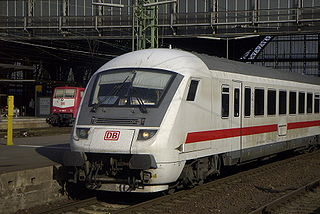
A control car, cab car, control trailer, or driving trailer is a non-powered rail vehicle from which a train can be operated. As dedicated vehicles or regular passenger cars, they have one or two driver compartments with all the controls and gauges required to remotely operate the locomotive, including exterior locomotive equipment such as horns, bells, ploughs, and lights. They also have communications and safety systems such as GSM-R or European Train Control System (ETCS). Control cars enable push-pull operation when located on the end of a train opposite its locomotive by allowing the train to reverse direction at a terminus without moving the locomotive or turning the train around.
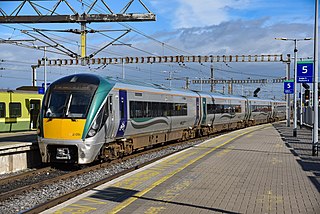
The 22000 Class "InterCity Railcar" is a diesel multiple unit in service with Iarnród Éireann in Ireland.

The 900/800 class railcars were diesel multiple units built by the New South Wales Government Railways between November 1951 and November 1960.

The Córas Iompair Éireann (CIÉ) 2600 Class were Associated Equipment Company (AEC)–engined diesel multiple units that operated InterCity and suburban services on the CIÉ system between 1952 and 1975. Many were later converted for push–pull operation with diesel locomotives, finally being withdrawn when displaced by the electric Dublin Area Rapid Transit service in the mid-1980s.

Diesel multiple units and railcars are trains, usually with passenger accommodation, that do not require a locomotive. Railcars can be single cars, while in multiple units cars are marshalled together with a driving position either end. As of December 2010, 23 percent of the rail passenger cars used on Network Rail are part of a diesel multiple unit.
The 1100 class railcar or Budd railcar were a type of diesel railcar built by Commonwealth Engineering for the Department of Railways New South Wales in 1961. They primarily operated on the South Coast Daylight Express until withdrawn in 1993.
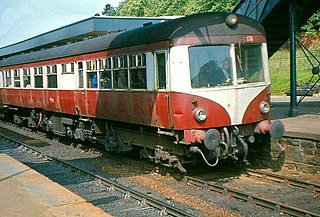
The GNRI BUT Class was a fleet of diesel-powered railcars operated by the Great Northern Railway Board and its successors between 1957 and 1980. They were an evolution of the earlier AEC railcars, which had entered service in 1951.
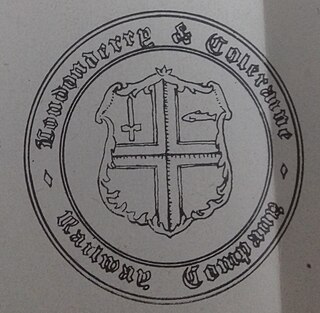
The Londonderry & Coleraine Railway is a railway line between the city of Derry and the town of Coleraine in County Londonderry, built by the Londonderry & Coleraine Railway Company (L&CR). The company operated the line independently for seven years before being absorbed into the Belfast & Northern Counties Railway. The line is still in use today by NI Railways and forms part of the Belfast to Derry-Londonderry main line.

















